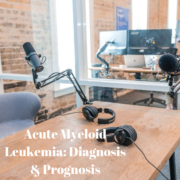Understanding and Managing AML Treatment Side Effects
AML expert, Dr. Jessica Altman, discusses how AML affects the body, and the common side effects patients may experience during varying AML treatment phases.
Dr. Jessica Altman is Director of the Acute Leukemia Program at Robert H. Lurie Comprehensive Cancer Center of Northwestern University. More about Dr. Altman here.
See More From The Fact or Fiction? AML Series
Related Resources

|

|

|
Transcript:
Patricia:
Dr. Altman, let’s talk about some common AML treatment side effects. What are some of the things that patients can expect when they begin treatment?
Dr. Altman:
So, the side effects depend in part on the actual treatment strategy that’s utilized. It’s also important to note that AML itself has symptoms, and so sometimes it’s hard to separate out the symptoms of the Acute Myeloid Leukemia and the symptoms from the treatment. Acute Myeloid Leukemia is a disease where the bone marrow is not functioning normally. The bone marrow is responsible for making healthy red blood cells, healthy white blood cells, healthy platelets, and also is very intimately involved with the immune system.
And so, patients with Acute Myeloid Leukemia by itself without treatment are at risk for fatigue if the hemoglobin is low, bleeding and bruising when the platelet count is low, and at risk for infections.
Also, shortness of breath and other side effects from having abnormal blood counts. In addition, the treatment frequently lowers the blood counts further, and the treatment itself increases those risks associated with low blood counts. Patients can be supported with blood transfusions. Patients are also supported with antimicrobial therapy to prevent infections, and if fever or infections occur despite that, patients receive additional antimicrobial therapy based on what the perceived organism is.
Patients with Acute Myeloid Leukemia, when they receive chemotherapy, are also sometimes at risk for something called tumor lysis syndrome.
That’s when we kill the leukemia cells, when the leukemia cells are killed quickly, sometimes the contents of the leukemia cells can inflame the kidneys and lead to alterations in the electrolytes and the acids and salts in the body, and that’s something that needs to be monitored for and prevented.
Patients with Acute Myeloid Leukemia who receive chemotherapy are also at risk for organ inflammation, and that is something that is monitored with the blood counts.
Patricia:
What can patients or their caregivers suggest to help manage some of these side effects?
Dr. Altman:
So, I think the biggest side effect that might be the hardest for us to manage and for patients to manage is fatigue. And I’m a believer that energy begets energy, and so trying to be as active as one can throughout all phases of their treatment I think helps the most. And also, the hopeful recognition that the fatigue should be self-limited, and that with time away from treatment, the energy should improve.
I think that’s one of the biggest things I hear from my patients.







![[ACT]IVATED [ACT]IVATED logo](https://powerfulpatients.org/wp-content/uploads/ACTIVATED-180x180.png)


